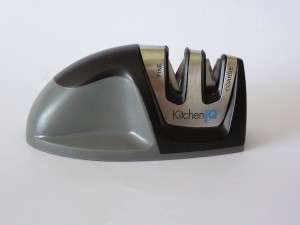How to sharpen a knife effectively is important. My knives are my treasured tools of the trade and most of these you see here I have owned since the early 1980s together with my beautiful end grain chopping board of the same era. Good care, maintenance and knife sharpening allows me to enjoy using them for years making my original purchase excellent value for money.
Like all cooks, using a sharp knife is a joy in itself. Unfortunately, all knives lose their sharp edge without regular sharpening and we all know that the worst cuts come from using a blunt knife. With a blunt knife you need to apply more pressure on to the knife to cut and if you slip, that pressure is translated to whatever bit of you is under the knife blade at the time (I feel faint just thinking about it).
Anyway, once upon a time I used to use a diamond sharpener but without care this can be the quickest way to ruin an edge on the blade. After much searching I think I have found the ideal sharpener for the home cook! The Scanpan Soft Touch Spectrum Mouse Knife Sharpener and Kitchen iQ Edge Grip are similar sharpeners and both are easy to use and safe.
Here is my suggestion on how to use it:
- Note that the sharpener (pictured below) has two V slots; one is grey (coarse, right hand side) and the other is white (fine, left hand side). The grey coarse one is recommended by Scanpan/Kitchen iQ if your knife is really blunt. I personally do not recommend the use of this slot as it is too severe on the blade. If your knife is so blunt as to warrant the use of this slot, I would suggest getting it professionally sharpened for a few dollars. After having it professionally sharpened it will be much easier to keep sharp.
- Ok, so we are only going to use the white V slot as this is the fine setting.
- Scanpan/Kitchen iQ recommend mounting the sharpener on the edge of a bench and dragging the blade through the sharpener (instructions come with the sharpener). I am not a fan of this technique for a couple of reasons: a) By dragging the blade through the sharpener it produces a downward slashing motion as the blade tip leaves the sharpener. You would not want anything or anyone contacting the blade at this point, as the blade is travelling fast and with some force. b) I have found that many people who use the sharpener this way apply too much force to the knife which damages the straight part of the blade but often applies too little pressure to the tip of the blade. Are you with me so far? Please read on, it will all make sense.
- We are going to use the sharpener a little differently. Instead, we are going to run the sharpener over the knife blade.
- Place the knife on the corner of the bench with the blade edge facing up and the blade tip about 25 – 50mm beyond the edge of the bench i.e. the back of the blade resting on the bench.
- Grip the sharpener with the index finger in the long V groove and your thumb and middle finger behind the protection ridges on either side of the sharpener.
- Using the white (fine) V only, rest the sharpener on the blade edge near the handle and run it along the blade until it falls off the tip of the knife. There is no need to put any downward pressure on the sharpener as the weight of the sharpener is sufficient to produce a sharp edge. Repeat 5 or 6 times.
- I do this procedure about once a week depending on how the blade feels when I am cutting with the knife.

The Scanpan Soft Touch Spectrum Mouse Knife Sharpener can be purchased from us at Sylvia’s Kitchen. Just email your enquiry via eat@sylviaskitchen.com.au.
Note: We have no affiliation with Scanpan or Kitchen iQ and have purchased and tested these product and similar mouse knife sharpeners ourselves and now share this information with you. Please share this on Facebook so it can help others who seek similar advice.
Happy Cooking! Sylvia



